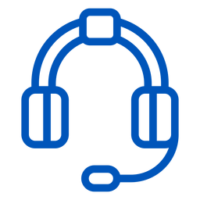The progressive dialer is one of the auto dialers – specific software tools that are used to automate outbound calling processes during telemarketing campaigns. As it follows from the definition above, there are different types of auto dialers – and a progressive dialer is one of two the most advanced ones. Progressive dialer can be considered a last stage of auto dialer development before the Predictive dialer – its more well-known brother.
Progressive dialer, as well as predictive dialer, is used by outbound progressive call centers for such purposes as telemarketing campaigns, lead generation, update of outdated contact bases, and warm calling as well. Moreover, we should even state that the outbound progressive dialer is more suitable to use with warm or hot calls, as it uses the algorithm of Power dialer in its core – and Power dialer is used to process warm contact lists only. The difference between Power dialer and Progressive dialer lies in the dialing pace, where outbound Progressive dialer wins, even though it shares most of its features with Power dialer – with the algorithm included in that list.
The main difference between predictive and progressive dialers lies not in the field of calling speed, but in the field of algorithms they use. Predictive dialer is called so because it starts dialing even when agents are still handling previous calls to get new calls ready exactly at the moment when the previous ones end. This provides the highest agent occupancy possible but requires at least 5 agents to be simultaneously active on the line, which means you won’t be able to run it without an appropriate number of agents. Progressive dialer, on the other hand, waits until agent is free to place another call – thus, if it uses dialing ratio 2:1 (2 calls are placed simultaneously), it requires 2 agents. In the terms of dialing pace, progressive dialer is close to the performance of predictive dialing mode which performs around 100 dials per hour.
Progressive dialer, as well as any other auto dialer, has an option to detect answering machines, busy signals, out-of-zone calls and others, which means it connects a progressive call to an agent only when there is a live person on the other side of the phone . Thus, progressive dialing mode can never cause dropped calls – calls which are answered by clients, but don’t have agents connected to them – but this is a double-edged sword: you will have higher agent idle time rate compared to predictive dialer’s case, which means a bit lower agent productivity. Agent availability is a main factor for Power dialer too.
Progressive dialers, as mentioned above, have many fields of implementation and use, including telemarketing, warm sales, hot sales, feedback collection, market research, customer follow-up calls, voicemail drops, etc. Even though it is almost as fast as predictive dialing mode is, it still can’t provide stable contact rate of 75% as its predictive colleague does, which means it isn’t the best-of-the-best option when it comes to cold telemarketing campaigns running.
Benefits of progressive dialers
Increased agent efficiency
Compared to manual dialing, progressive dialers provide almost the highest rate for contact center agents occupancy with real calls, losing to predictive dialer only. On the other hand, progressive dialer can be used for much more purposes than predictive dialing mode, which means if you are not limited to cold calling only and you want your agent to show their best, then the progressive dialer is a great option. Higher agent occupancy means more calls per agent, and more agent talk time.
Fewer hang-ups
Progressive dialer itself eliminates the issue of dropped calls, as it never initiates the call unless there is a free agent. Thus, when it comes to working with warm bases, where dropped calls are unacceptable, progressive dialer has no alternative – if not taking into account its brother, Power dialer. Using a progressive dialer will ensure that agents will be able to talk to every customer who have answered the call, and there will be no call abandonment rates.
Better goal conversion
Overall efficiency of a progressive dialer helps it to improve conversion rates for both warm and cold calling, which means you will sell more by just adopting this solution which isn’t a huge investment even for a small business or individual entrepreneur. Progressive dialer is also a great solution as it doesn’t require as many agents as predictive dialer, so you can use it even if you have 1 salesman in your staff.
Frequently Asked Questions
How does the functionality of a progressive dialer differ from other dialing systems?
A progressive dialer operates by automatically dialing phone numbers from a database, specifically connecting agents to live contacts while bypassing busy lines, answering machines, and unresponsive numbers. In the outbound mode, the system strategically waits for a call center agent to conclude their ongoing call before dialing the next number, ensuring that only one number is dialed per agent.
When is it preferable to employ progressive dialers instead of predictive dialers in a contact center setup?
Predictive dialers excel in scenarios involving large outbound call center teams and extensive proactive calling campaigns such as telemarketing, sales, market research, and collections. However, for smaller to mid-sized teams with fewer agents available to align with the demands of predictive dialing, progressive dialers offer a more suitable alternative. Moreover, progressive dialers prove advantageous in B2B outbound calling situations, as these calls typically exhibit a higher success ratio with fewer hang-ups and superior answer rates, often exceeding 80

